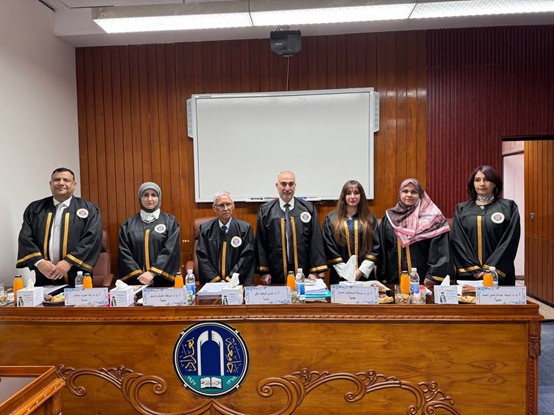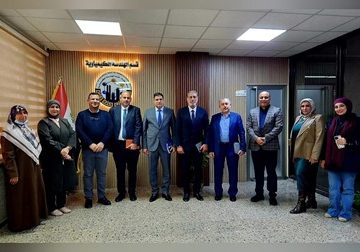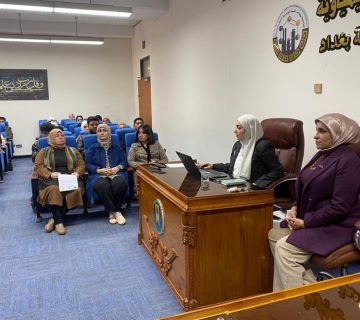The Chemical Engineering Department at the College of Engineering, University of Baghdad, held a Ph.D thesis examination titled:
“ Advanced Oxidation of Organic Pollutants in Refineries’ Wastewater Over Heterogenous Fenton-Catalyst Coupled with UV Irradiation“
By the student Sanarya Kamil Kamal and supervised by Prof. Dr. Ammar S. Abbas. The examination committee consisted of Prof. Dr. Hasan F. Makki as Chairman and the membership of Assist. Prof. Dr. Muslet Sh. Hussain, Assist. Prof. Dr. Rasha H. Salman, Assist. Prof. Dr. Basma I. Waisi, and Assist. Prof. Dr. Shaymaa A. Ahmed. After conducting the public discussion and listening to the student’s defense, the thesis was accepted. The thesis was summarized as follows:
The The photocatalytic advanced oxidation process using a heterogeneous prepared catalyst was used to degrade organic contaminants in synthetic, and real refinery wastewater was investigated. The catalyst was synthesized by applying an ion-exchange method. The iron exchange conversion increased with temperature and reached 0.519 at 80 °C after 8 h. The Langmuir-Hinshelwood-Hougen-Watson model described the ion exchange experimental data well with high correlation coefficients. The activation energies were 31590.7 J/mole and 28105.5 J/mole for the forward and backward reactions, respectively. The prepared catalyst was characterized by atomic absorption spectrophotometry, X-ray diffraction, X-ray fluorescence, Fourier-transform infrared spectroscopy, atomic force microscopy, Brunauer-Emmett-Teller surface area, and filed emission scanning electron microscopy-energy dispersive X-ray spectrometer. Characterization of the catalyst confirmed the iron oxide structures exchanged with the zeolite surface.
The Taguchi experimental design method with an L27 orthogonal array was used to investigate the heterogenous Fenton oxidation reaction. The experimental design covered various operating conditions, including different catalyst loads (0.2, 0.7, and 1.2 g/L), power of hydrogen (3, 5, and 7), irradiation times (30, 60, and 120 min), temperatures (20, 40, and 60 °C) and the presence of oxidation reagent. The degradation process was studied at various initial phenol concentrations (50, 100, and 200 mg/L) with an initial chemical oxygen demand of (164, 251, and 492 mg/L). The most significant parameter for removing chemical oxygen demand efficiency was the power of hydrogen, and the least effective parameter was the catalyst load. The optimal value of average experimental and predicted chemical oxygen demand removal was 88.50 and 87.32 % at 60 °C, respectively. A general lumped kinetics model has been studied for chemical oxygen demand degradation through two irreversible reactions in series of converting phenol to intermediate organics and intermediate organics to carbon dioxide and water. The reaction rate constants were 0.36 to 1.51 h-1, and 251283.09 to 1938897.79 h-1 for the first and second reactions. The best conditions for degradation coupled with UV and using 20% excess of the oxidation agent gave complete removal of 200 mg/L phenol during the first hour and chemical oxygen demand after 2 hours, using the photocatalytic system, power of hydrogen about 3, 0.7 g/L catalyst load, and temperature 40°C. However, organic pollutants were removed at 85.29 and 81.67% for Dora Refinery and North Gas Company wastewaters, respectively.
The effect of light type (dark, visible light, ultraviolet irradiation) was investigated at different conditions for synthetic and refinery wastewater. The lowest contaminants removal was obtained under dark conditions, and the reduction improved when visible light was used, while the best removal was obtained by UV irradiation for all wastewaters.
Furthermore, the iron-doped zeolite displayed excellent stability and could be reused at least five consecutive times without losing activity. The degradation power consumption ranged from 691.18 to 826.96 kWh per kg of chemical oxygen demand.
The kinetics of phenol degradation through a photocatalytic followed the first-order kinetics with no significant effects of mass transfer on the reaction rate. The kinetics models for chemical oxygen demand and phenol degradation were used to simulate the removal of organic contaminants using different types of ideal reactors, namely mixed flow and plug flow. The simulation results show that the plug flow reactor performed better than the mixed flow reaction for removing organic pollutants from wastewater. The research revealed that the heterogenous photocatalytic Fenton process was the most successful treatment method using the prepared iron-doped zeolite in short radiation time compared to the heterogenous Fenton process.








